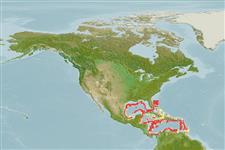Common names from other countries
Elasmobranchii (tubarões e raias) (sharks and rays) >
Carcharhiniformes (Ground sharks) >
Pentanchidae (Deepwater catsharks)
Etymology: Apristurus: a-, Latin privative, i.e., without; pristis, from pristes (Gr.), sawyer (but here meaning saw); oura (Gr.), tail, referring to absence of saw-toothed crest of enlarged dermal denticles along upper edge of caudal fin as found in the closely related Pristiurus (=Galeus). (See ETYFish); riveri: In honor of biologist-anthropologist Luis Hugo Howell-Rivero (1899-1986), for his contributions to Cuban ichthyology (this shark described from the north coast of Cuba). (See ETYFish).
Environment: milieu / climate zone / depth range / distribution range
Ecologia
marinhas batidemersal; intervalo de profundidade 700 - 1500 m (Ref. 55584). Deep-water; 30°N - 9°N
Western Central Atlantic: Cuba, northern Gulf of Mexico, and Panama.
Tamanho / Peso / Idade
Maturity: Lm ? range ? - ? cm
Max length : 46.0 cm TL macho/indeterminado; (Ref. 244); 41.0 cm TL (female)
Relatively slender, moderately long, narrow snout and relatively narrow, low caudal fin. Color uniform dark brown (Ref. 37039). First to third gill openings long as the distance between the nostrils (Ref. 6032).
Found on the continental slopes. Oviparous, with one egg per oviduct laid at a time. Sexual dimorphism in adults unusually well-developed.
Life cycle and mating behavior
Maturities | Reprodução | Spawnings | Egg(s) | Fecundities | Larvas
Oviparous, paired eggs are laid. Embryos feed solely on yolk (Ref. 50449). Sexual dimorphism is evident in dentition of males (Ref. 49562). Males have longer teeth with fewer cusps (Ref. 51093) to make 'courtship biting' more effective (Ref. 49562).
Compagno, L.J.V., 1984. FAO Species Catalogue. Vol. 4. Sharks of the world. An annotated and illustrated catalogue of shark species known to date. Part 2 - Carcharhiniformes. FAO Fish. Synop. 125(4/2):251-655. Rome: FAO. (Ref. 244)
Categoria na Lista Vermelha da IUCN (Ref. 130435)
CITES (Ref. 128078)
Not Evaluated
Ameaça para o homem
Harmless
Utilização humana
Pescarias: sem interesse
Ferramentas
Relatórios especiais
Descarregue XML
Fontes da internet
Estimates based on models
Preferred temperature (Ref.
115969): 4.9 - 7.9, mean 5.7 (based on 95 cells).
Phylogenetic diversity index (Ref.
82804): PD
50 = 0.5000 [Uniqueness, from 0.5 = low to 2.0 = high].
Bayesian length-weight: a=0.00355 (0.00176 - 0.00714), b=3.09 (2.91 - 3.27), in cm Total Length, based on LWR estimates for this (Sub)family-body shape (Ref.
93245).
Nível Trófico (Ref.
69278): 3.8 ±0.4 se; based on size and trophs of closest relatives
Resiliência (Ref.
120179): Muito baixo, tempo mínimo de duplicação da população maior que 14 anos (Fec assumed to be <10).
Fishing Vulnerability (Ref.
59153): Moderate vulnerability (36 of 100).
